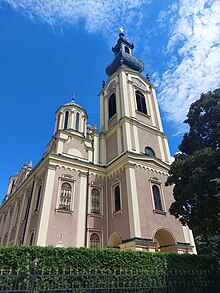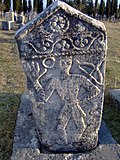Cathedral of the Nativity of the Theotokos, Sarajevo
| Cathedral Church of the Nativity of the Theotokos | |
|---|---|
Саборна Црква Рођења Пресвете Богородице Saborna Crkva Rođenja Presvete Bogorodice | |
 Serb Orthodox Cathedral | |
| Religion | |
| Affiliation | Serbian Orthodox Church |
| Year consecrated | 20 July 1872 |
| Location | |
| Location | Trg Oslobođenja - Alija Izetbegović / Zelenih Beretki, Sarajevo, Bosnia and Herzegovina |
| Architecture | |
| Architect(s) | Andrey Damyanov |
| Style | Baroque |
| Completed | 1874 |
| Designated as NHL | |
| Official name | Orthodox Cathedral church (church of the Holy Mother of God) with movable heritage, the historic building |
| Type | Category I monument |
| Criteria | II. Value A, B, C i.ii.iii.iv.v.vi, D i.ii.iii.iv.v., E i.ii.iii.iv.v., F i.ii., G i.ii.iii.iv.v.vi, I i.ii.iii.iv. |
| Designated | 5 July 2006 (session No. ) |
| Part of | Old Town of Sarajevo |
| Reference no. | 2842 |
| Decision no. | 06.2-2122/06-5 |
| Listed | List of National Monuments of Bosnia and Herzegovina |
| Operator | - |
| Website | |
| http://www.mitropolijadabrobosanska.org/ | |
The Cathedral Church of the Nativity of the Theotokos (Serbian: Саборна Црква Рођења Пресвете Богородице, romanized: Saborna Crkva Rođenja Presvete Bogorodice) is the largest Serbian Orthodox church in Sarajevo and one of the largest in the Balkans. The cathedral is designated National Monument of Bosnia and Herzegovina by the KONS.
The cathedral is dedicated to the nativity of the Theotokos. It was erected at the request of the Orthodox parish of Sarajevo, with construction taking place between 1863 and 1868. The church is constructed as a three-section basilica inscribed in a cross-shaped plan, and has five domes. The domes are built on the beams; the central one is much larger than the other four side domes. The church is arched by round elements. The small gilded baroque-style belfry is built in front of the entrance. The interior walls are decorated by painted ornaments. In the lower zones of the walls the painted ornaments are simulating the marble stone construction look. Arches and vaults are decorated in ornaments only. In 1898, the Orthodox Metropolitan Palace was built near the cathedral.
The head master for construction was Andreja Damjanov, a man from the Damjanovi-Renzovski family of master builders, masons, painters, carpenters, and stonecutters from the village of Papradište, near Veles.
History
The construction of the church commenced in 1863 when Sarajevo was part of the Bosnia Vilayet, itself a subdivision within the Ottoman Empire. Most of the 36,000 dukat construction cost was covered by Sarajevo's Serb merchants, led by Manojlo Jeftanović who donated 2,000 dukats.[1] In a symbolic act, the Ottoman sultan Abdülaziz and the ruler of Serbia, Prince Mihailo Obrenović, each donated 500 dukats.[1] Russian Tsar Alexander II sent expert craftsmen to construct the iconostasis. Known locally as the 'New Orthodox Church' to distinguish it from the sixteenth-century church a few hundred meters to the east, it was the first building to break the Muslim monopoly on monumental edifices in Sarajevo.

Once the church was built, its tower that rose above many of the town's mosques became a sore point with local conservative Muslims who wanted traditional limitations on non-Muslim architecture to be imposed. The same group also objected to a small bell that was installed on the old Serbian Orthodox Church at around the same time. The new church dedication ceremony was scheduled for May 1871; however, a group of forty lower-class Muslims, led by a Sarajevo imam Salih Vilajetović (better known as Hadži Lojo), sought to block it.[1] When notified of the intended obstruction, the Bosnian Vilayet's Ottoman governor ordered the police to arrest Hadži Lojo and his followers. Six were arrested while others fled when the police arrived. Led by merchant Jeftanović, members of the Serbian community lodged a protest with the Russian consul in Sarajevo, and Russian diplomats shortly thereafter protested the episode to the Ottoman sultan. The dedication ceremony was postponed for a year.
The next year, in the summer of 1872, the Ottoman officials dispatched a new military commander with more than thousand men in order to provide security for the church dedication. Concerned about local Muslim vandal attacks, as a show of force the Ottoman governor ordered the positioning of a cannon above the city and the deployment of troops to guard the ceremony. The festive dedication on 20 July 1872, attended by high Ottoman officials and by the young Austro-Hungarian ambassador to Serbia, Béni Kállay (who would later play an important role in Bosnia), proceeded without incident.[1]
Heritage designation
The Cathedral Church of the Nativity of the Theotokos is designated National Monument of Bosnia and Herzegovina by the Commission to Preserve National Monuments of Bosnia and Herzegovina on the session held on 4 July 2006.[2]
See also
References
- ^ a b c d Donia 2006, p. 34.
- ^ "Orthodox Cathedral church (church of the Holy Mother of God) with movable heritage, the historic building". old.kons.gov.ba. Commission to preserve national monuments. 4 July 2006. Retrieved 15 July 2023.
Books
- Donia, Robert J. (2006). Sarajevo: A Biography. London: C. Hurst and Co. (Publishers) Ltd. ISBN 0-472-11557-X.
External links

- Official website (in Serbian)
43°51′30″N 18°25′30″E / 43.8582°N 18.4251°E / 43.8582; 18.4251
- v
- t
- e

| City proper | |
|---|---|
| Urban area | |
| Metro area |
- Alipašino polje
- Babića bašća
- Baščaršija
- Čengić vila
- Dobrinja
- Grbavica
- Džidžikovac
- Hrasno
- Koševo
- Mejtaš
- Marijin dvor
- Otoka
- Višnjik
- Vratnik
landmarks
- Ambassadors' Alley
- ARIA Centar
- Avaz Twist Tower
- Bijela Tabija
- Bosmal City Center
- Clock Tower
- Despić House
- Eternal flame
- Goat's Bridge
- Greek-Bosnian Friendship Building
- Latin Bridge
- Morića Han
- Presidency Building
- Sarajevo Rose
- Sarajevo Tunnel
- Sarajevo Zoo
- Šeher-Ćehaja Bridge
- Skakavac Waterfall
- Svrzo's House
- UNITIC Towers
- Vidovdan Heroes Chapel
- Vraca Memorial Park
- Suada and Olga bridge
- Vrelo Bosne
| Muslim |
|
|---|---|
| Catholic | |
| Orthodox |
|
| Jewish |
museums
| Public | |
|---|---|
| Private |
| Stadiums | |
|---|---|
| Indoor arenas |
- Ferhadija street
- Marshal Tito street
- Sarači street
- Trg Oslobođenja - Alija Izetbegović
- Vilsonovo Šetalište
- Baščaršija Nights
- Sarajevo Winter Festival
- Jazz Fest Sarajevo
- Sarajevo Film Festival
- Balkan Photo Festival
- Pop-Up! Sarajevo
- WARM Festival
- Ilidža Folk Music Festival
- Al Jazeera Balkans Documentary Film Festival
- Pravo Ljudski Film Festival
- Sarajevo Youth Film Festival
- Sarajevo StreeAt Food Festival
- OPEN Fest Sarajevo
- MESS International Theatre Festival
- Sarajevo Pride
- Sarajevo Chamber Music Festival
- Sarajevo Beer Festival
- Sarajevo International Guitar Festival
- Ballet Fest Sarajevo
- Sarajevo Ramadan Festival
- Spiritus Progenitum
 Category
Category
















